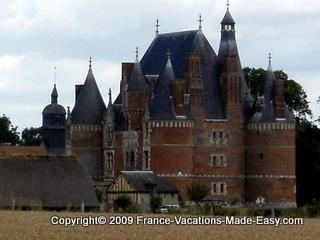|
[?]Subscribe To This Site
|
Martainville Chateau
In spite of it being the long way around, coming from the direction of my house, I do prefer taking the road from Rouen, just for this reason.
The ApproachQuite often, the original approach roads to these jewels of architecture are no longer accessible. Modern car usage has altered traffic patterns and caused detours around these places, making access possible only from skewed angles which must make their architects squirm in their graves. Renaissance designers had the whole experience planned out to a “t”. The approach was through a tree lined drive. The longer it was, the more majestic the trees, the more important the owner of the great house or chateau. Of course the locations of military fortresses were different for obvious reasons. Woods surrounding a military stronghold would provide camouflage for the attacking enemy. Therefore, if a castle is set in an open area on a rise or promontory above a valley, its vocation would be of strategic rather than social value. The Martainville chateau was built as a country residence for a very prominent family of businessmen from Rouen. They were most definitely looking to display their stature in society with the grandeur of their weekend residence. Grand it was and grand it remains, in spite of the approach road veering off to the left at the last minute, the destination no longer this particular residence, but rather some town further along the road. You do get a great view at an opportune instant; unfortunately you cannot stop the car and get a full frontal photo. The car park is located at one side, as well as the entrance to the grounds. I suspect that the entrance used by visitors today would quite possibly have been originally been used for livestock or at best suppliers. This seems very wrong somehow and diminishes the impact this amazing building should have on anyone seeing it for the first time. Hence my car detour for my guests so that they may at least get a quick “Holy Cow!” view of the Martainville chateau before its dismissive side approach on foot.
The HistoryBuilt in 1485 by Jacques Le Pelletier, of the afore-mentioned wealthy family of business men from Rouen whose holdings were primarily in ship trade from the nearby Norman coast, the original design of the Martainville chateau was decidedly military in aspect, but with some very modern touches, such as the decorative glazed brickwork. The interior of the castle boasted some thoroughly modern traits as well. All of the rooms branch off from a central hall, a design concept considered innovative for the times. But the special treat for the inhabitants was, undoubtedly, the inclusion of fireplaces on all of the upper floors in each of the larger rooms. This was rarely the case in the 15th century. Because heat rises, the farther up you go, the less important the fireplace becomes. The servants’ quarters in the upper floors of less well-conceived great houses were freezing. The inhabitants of the Martainville chateau were very fortunate indeed. Several years later, his nephew Jacques the second, Le Pelletier brought about some structural changes, modernizing the house even more. The moats were filled in, the drawbridge was replaced with a sculpted stone entrance and walls were built around the perimeter of the garden. Outbuildings were added to house the necessary stables, cider press and store rooms. He also enlarged the window casements, bringing in more light. The castle no longer resembled the military fortress of his uncle's days, but more and more a dignified, sumptuous residence flanked by four towers on each of its corners. It was during this time that he earned the title of viscount of Martainville, further glorifying his family by officially entering the nobility, a huge achievement for a bourgeois family of entrepreneurs. Throughout the years after Jacques the 2nd, the estate was passed from father to son until 1757, when the family lineage seems to have been interrupted. The estate entered a period of instability and was sold from family to family. In 1905 it came into the hands of a livestock trader who bought the Martainville chateau as well as part of the lands. Under his direction, the tree lined drive was cut down, and the demolition of the castle began. The state government stepped in at the last minute and retrieved the estate. Unfortunately, the furnishings had all been dispersed by then and the castle itself had already suffered periods of abandonment as well as occupation by the Prussian army. Finally, in 1955, the French government started restoration work and in 1965 a museum was opened in the castle, with the theme Norman arts and traditions.
Visiting the Martainville Chateau TodayThe ground floor of the museum is given over to traditional furniture ranging from the XVth century to the XIXth century. The 2nd floor is devoted to daily life in the region, and houses rooms with kitchen utensils and home crafts. The Upper floor has a nice collection of traditional clothing from the XVIIIth and XIXth centuries. Today this museum is open to the public daily except Tuesdays, Sunday mornings and certain holidays from 10am to 12:30pm and then again from 2pm until 5pm during the winter months and until 6pm in the summer. The entrance fee is € 3. There are special over 60 rates and students can visit for free. Well worth the small entrance fee!
Return to France Vacations Made Easy Home Page |
|



 About 25 kilometers northeast of Rouen (
About 25 kilometers northeast of Rouen (